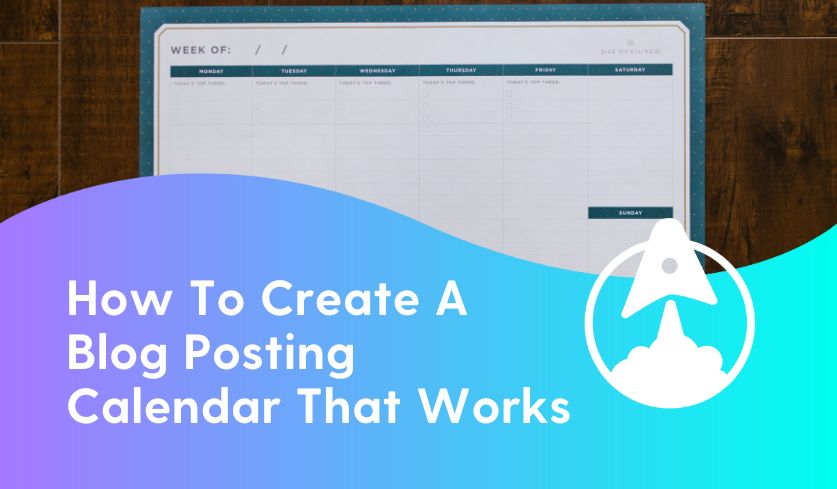Keeping up to date with your blog isn’t an easy feat. It requires time, attention, research, and careful planning. To organize your content scheduling, you can create a blog posting calendar. This is the main project management tool behind your content strategy. It’s a living, breathing record of your content plan. It covers and organizes your ideal publish dates, target keywords, blog post ideas, and types of content.
A great blog posting calendar is more than just a shiny calendar tool. It’s a detailed, clear path to consistently posting content that makes a difference in the lives of your target customers. Below you’ll learn all the ins and outs of easily creating and maintaining an effective blog posting calendar.
What is a blog posting calendar?
Okay, let’s start with the basics. A blog posting calendar (AKA “content calendar” or” editorial calendar”) is a space — typically a digital one — to schedule and plan your content. You can use it exclusively for blog posts, or you can include other types of content in the calendar, such as social media posts.
You can create your blog posting calendar using a calendar tool, a spreadsheet, or project management software. The choice is up to you, as are the categories within your calendar. You can choose whether or not you track the author of a piece, the review process, or the due dates. There are some definites to include for each piece of content, though, such as the topic to be covered and the target publish date.
Who needs a blog posting calendar?
A blog content calendar is crucial for any individual or business that posts blogs (or any type of content). And since content remains king — and likely always will — almost every brand and small business should produce it. To cut to the chase a bit: Every editorial team or marketing department needs a blog content calendar to stay organized.
When you sort out content ideas and plan ahead through a blog posting calendar, you’re more likely to hold yourself accountable and publish well-written pieces. Your calendar can also give people other than your writers an idea of what’s coming down the pipeline.
Why is a blog posting calendar important?
As you expand your online presence, you’ll quickly realize that tools to help manage your upcoming projects are your new best friends. There are a couple of clear reasons why content calendars are a lifesaver, and then there are some you might not have considered. Here, we’ll explore some of both.
A blog posting calendar is important because it:
Enables better organization
With a dedicated space for planning content, you’re more likely to get organized and stay that way. Instead of using your regular work calendar and adding content to the mix of a million other things, a dedicated content calendar is less cluttered. It can truly keep you sane at work.
Initially, there may be some legwork to transfer your ideas and miscellaneous documents into one cohesive record. However, once you get your calendar up and running, it should be easy to maintain and save you other headaches.
Achieves posting consistency
It’s easy to fly by the seat of your pants as you post blogs or share content — maybe you typically just post on a whim. This isn’t a particularly strong strategy, and a blog posting calendar can help you stick to a strategically meaningful schedule.
You can lay out your blog post ideas with upcoming deadlines to hold you and your team accountable. Then, when you post each blog, you can couple it with social media posts — and posts on other channels — to promote your blog elsewhere. You can build these best practices into your schedule to maximize clicks, likes, and conversions.
Provides an overview of your content plan
With everything mapped out, you can easily glance at your content marketing plan whenever you need to touch base with other departments. You’ll know what’s coming up and where there’s room to add post ideas and deadlines. You’ll have everything at your fingertips to take the stress out of knowing where you stand in content land.
Allows for time off
A robust content calendar dictates when your posts and pieces should go live. This information is all you need to automate the publishing process. This means that, if you’re planning on taking some time off, you can simply create the content in advance. You can then plug it into the pipeline with timed releases. Plus, if you can’t complete everything before your time off, a good content calendar tells your other writers to step in without missing a beat.
Cuts down on the chances of errors
Without a plan, a schedule, and some prep work, you’re more likely to rush out content that gets published with errors. Now, typos are funny in other people’s work, but they lack the same humor when it happens to your work. So skip the headache of going back and correcting published pieces and, instead, create a content calendar that leaves ample time for proofreading.
Helps align content with holidays
Things move fast on the internet — trends and occasions come and go in the blink of an eye. This matters if you want to be timely with your posts about holidays and events. If you have a blog idea for “National Sandwich Day,” post your blog day-of — not the day before or the day after. A content calendar lets you scope out holidays and events and plan publishing dates accordingly to keep your content relevant.
Provides an opportunity to better track content
When you share content online, you want the right people (your target audience) to see it. This involves a lot of research, trial and error, and tracking analytics. Some calendar tools allow you to monitor a post’s performance right there and then. This is paramount — it’s vital to measure performance consistently in SEO content writing so that you can keep reaching people searching for relevant terms.
What should be in a blog content calendar?
Your blog posting calendar should include topics, content types, publication dates and times, content authors, publishing channels, deadlines, and copy status. For status, you can state whether the piece is live, being drafted, or in the review process. You can also include keywords, word count, and relevant links.
What are the stages of blog content development?
To start the process, you’ll generate a topic idea and decide the category it covers. This category can be broad (for example, health, beauty, finance) or more niche (for example, a narrowly defined service you offer). After that, you’ll decide the keyword that’s the best fit for your content and its goals. From there, you’ll develop a headline, subheadings, and sections. All of these steps are important in SEO content writing.
Finally, you’ll source images, define your call to action, write the first draft, and make the first edit. You’ll then publish it and, occasionally after that, audit it to see whether any updates are necessary.
How to build a blog posting calendar you’ll actually stick to
For a content calendar to succeed, you have to stay on schedule. Here are some ways you can lay the foundation for a steady followthrough.
1. Decide on a platform
To begin, you’ll want to find a calendar platform that works for you and your team. You can go spreadsheet-style with Google Sheets, create a shared Google Calendar, or use a project management tool. You can also build your calendar from content calendar templates.
2. Research your keywords
Knowing your audience and what they’re searching for is a great way to spark content ideas that’ll perform well. This means breaking out your keyword tools and getting to work. You can develop a list of trending keywords that you constantly monitor and update. This can be a great source of inspiration when you’re running dry on ideas.
3. Generate content ideas
Now that you have a rough idea of relevant topics, you can brainstorm more concrete ideas for blog posts, including upcoming holidays and events. Once you have an idea, you can do more research to see what others have written about it. In doing so, you can determine how to add something meaningful to the conversation.
4. Plan out posts for the month
With your topics at the ready, it’s time to plan out your content for the upcoming month. This way, you’ll know what’s coming in the next few weeks, with due dates to monitor your workload. When planning for the month, you should consider realistic deadlines and work with your team to figure out how often to post.
5. Set your deadlines as definite
If you’re honest with yourself and you schedule reasonable due dates, you shouldn’t consider them as mere suggestions. To stay on track, you can note where you are in the process of writing — label it as “not started yet” or “in progress.”
It’s also wise to keep your publish date separate from the deadline, with enough space between the two to account for the review process. You should also allow your editors the time to review the piece — and for yourself to work on revisions.
6. Go live across your channels
When building your calendar, it’s important to remember that content sharing doesn’t stop when you hit publish. You’ll also share your content on other channels. This means you should sync your content deadlines and posting schedule with the schedule for the platforms you’ll use to promote your blog posts. Be sure to create a plan for going live across all relevant channels in your content calendar.
5 tools you can use to manage your blog posting calendar
Many tools out there can help you manage your content creation and establish a successful blog posting calendar. With the management tools listed below, you can stay organized without using too many platforms and feeling overwhelmed.
1. Google Sheets for calendar management
Google Sheets can act as your classic spreadsheet base for your content calendar. This free tool lets you customize categories and share your constantly evolving document with your team members. You can color code the record — plus, it’s highly visual and easy to follow.
2. Google Alerts for keyword research
With Google Alerts, you can track various keywords and phrases and set up notifications to alert you when content is published about them. This way, you can stay in the loop on your niche. If an especially interesting subject is trending, you can shift your content calendar to accommodate new content on this hot lead.
3. Grammarly for proofreading
Every writer or editor can always use a little extra support when reviewing copy. That’s where Grammarly comes in — it’s a great way to run your writing through a more sophisticated spell checker. Plus, depending on your plan, you can also spot and correct more intricate grammar errors.
4. Hootsuite Planner for social media scheduling
This social media management tool lets you plan, create, and schedule posts on different channels. You can easily adjust when your content goes live and get suggestions on the best time to post.
5. Hubspot for holiday tracking
If you want to see upcoming holidays and events at a glance so you can plan content around them, you might love Hubspot’s holiday calendar suggestions. They can show you countless national holiday, awareness months, and “just for fun” social media holidays that may apply to your business. You can download the calendar into your own calendar or save relevant events individually. This way, you’ll only be aware of holidays you can use to generate relevant content for your business.
How often do you need to post a blog?
The short answer is that there’s no hard and fast rule for post frequency. However, it’s important to publish regularly. Even if you’re only posting two blogs a month, that’s plenty to start with. Search engines pick up on consistency. It’s also great for building a sustainable workflow, especially if you’re new to producing content for your company. You should find a flow that works for you and your team and stick to it using your content calendar. A blogger that posts consistently has a higher chance at an overall better ranking performance.
How far out should I plan my blog posting calendar?
This also depends on your time and bandwidth, though it always helps to plan out content a month in advance. With a thorough content calendar, you can get a rough idea of the next several months or the rest of the year. At the same time, new ideas and trends will inevitably pop up, so nothing is set in stone. But rough guidance is better than none.
Stay consistent in quality with SCS Creative
Not everyone has the time or team to follow a content schedule. It’s easy to miss a posting day and then another, and another — and before you know it, weeks or months have passed. A content writing agency can take the stress out of meeting your deadlines.
At SCS Creative, we have the skills, team, and resources to create timely content for your blog. You can create your own content calendar and leave the content creation to us, or we can work together to develop ideas. Our team has experience covering numerous industries and topics, so we’ll arm you with quality as well as quantity. Setting a calendar is a big step — after that, we’ll create the content you (and your readers) have always needed.






